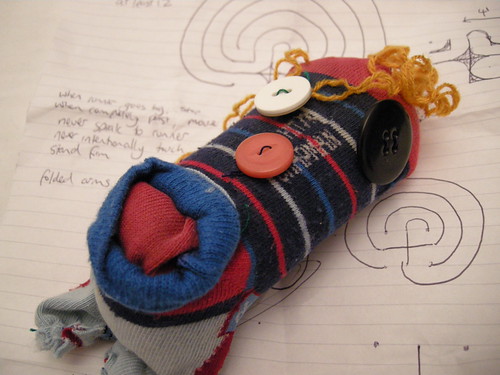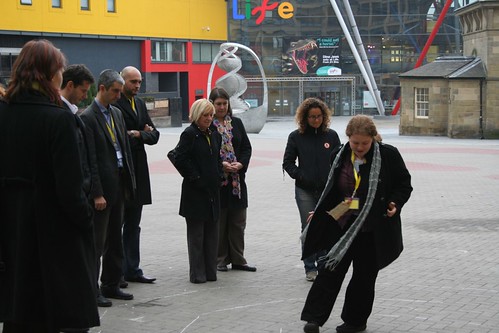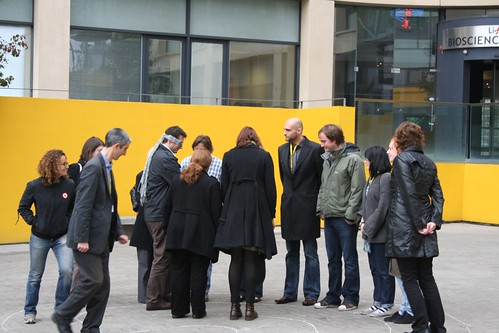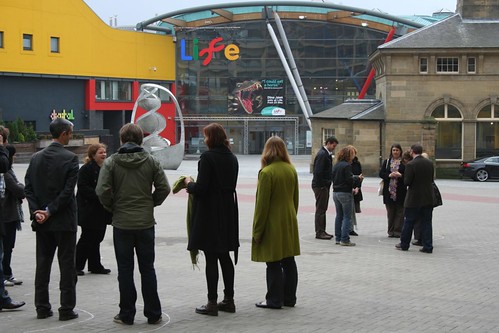MuseumNext: wild ideas about participation
I’ve just got back from Newcastle and the rather marvellous MuseumNext event led by Nina Simon and Jim Richardson:
a two day workshop event … for museum professionals who are interested in innovative new ways to energize audiences and create more engaging experiences for museum and gallery visitors.
Hardly any surprise then that the introductory getting to know you sessions took place amongst the Great North Museum‘s Doing it for the Kids exhibit from [re] design.
We made sock aliens; constructed quilt panels from Action man clothes; killed virtual spiders; and made Frisbees out of milk bottles (of the plastic variety).
It wasn’t long though before we were down to the serious business of the 7 Wild Ideas that had been submitted to the conference as the case-studies we would work on.
I joined the Exhibition Gaming team in response to Daniela Bauer’s vision of museum visitors being pawns in a game. Unlike some of the other Wild Ideas that were very much linked to specific contexts faced by particular institutions, Daniela was approaching this as a Psychology researcher and so our discussion was in general terms rather than attached to a particular location or design brief.
That didn’t stop it from being very in-depth though.
I first came across some of the awesome participatory work being done by museums via people from the sector involved in games such as Superstruct and Signtific Lab. Although I’ve as yet had no direct experience of working with museums, the discussions I’m reading coming from this direction have definitely inspired and influenced my thinking regarding participation. I therefore attended MuseumNext expecting to be out of place – in a good way – and expecting to learn loads.
I was and I did! Hurrah!
I’m fairly sure we didn’t answer any of Daniela’s initial questions, but in exploring them we came up with about 20 new questions. These questions were quite wide-ranging, but also with a significant amount of overlap. We were originally trying to work towards a framework for designing a museum-based game, but I think what we may have ended up with was more like a framework for institutions to start putting together a design brief for a potential game.
The second day of MuseumNext started off with a very interesting presentation from Nina about participatory museums, after which we had two un-conference sessions. Incentivised by the prospect of being able to take a sock alien home (he needs a name, btw) I had offered to run a practical Lost Sport of Olympia session.
Although the people in our Wild Idea group had some great ideas about doing interesting stuff in interesting places, not many of them seemed to have had any experience of being on the receiving, playing end of such things. I thought the best thing I could offer was to give them a chance to actually feel what it’s like to be in a group of strangers doing something a bit odd in a public place. I asked for chalk and permission to temporarily deface the forecourt of the Centre for Life and got both.
So, I missed the first of the un-conference sessions because I was outside figuring out how to draw a couple of labyrinths without the usual marked-out length of string. Fortunately the ground was paved with bricks so I was able to use a combination of counting them and using my shoes to measure out radii.
It was well worth the effort – a good group of people decided to brave both the weather and the public gaze to come outside and play for the second un-conference session.
After the un-conference sessions wrapped up, we reconvened our Wild Idea groups. Daniela had identified three parties that she wanted to investigate their motivations for getting involved in museum gaming: the institution, the audience and the urban gamers (there was a little confusion over this, but I think she meant the game designers, rather than players already in pervasive/urban gaming communities). It was really useful to examine these three groups and see where their motivations overlapped and where they differed.
After that we returned to our big list of questions and, working in threes, we tried to answer a few each. Again, I learned loads from this.
I’ve been working with game mechanics both in my own work (for example, Emergent Game and the Bournville scavenger hunt) and also through BARG for a year or two now, and I’m keen to start applying some of my skills to some issue-led contexts. I want problems to try and address!
I gained a lot through speaking with museum (and psychology!) professionals of all sorts and it has really helped me to better appreciate the sorts of issues institutions might be trying to address through the use of games and playful experiences. Also what the main concerns they may have in doing this and where likely pitfalls may be.
A massive thank you to all the MuseumNext team and all the participants: I have a feeling that the effects of this one will be reverberating around for quite some time to come.



